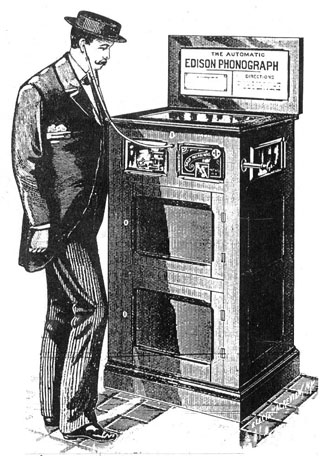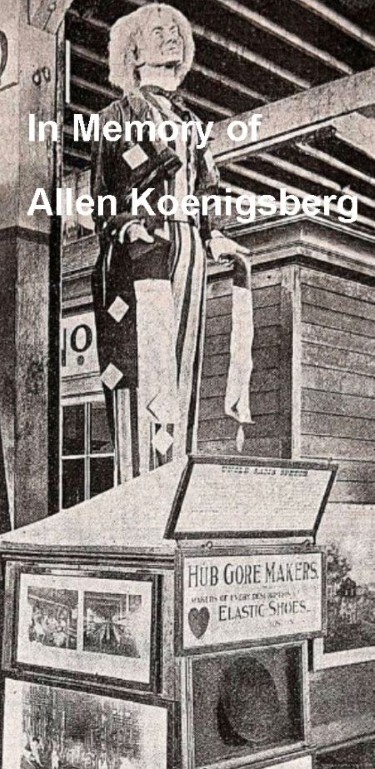Allen Koenigsberg

"Persistence, if nothing
else..."
A Friend of the Phonograph
In Memory of Allen Seymour Koenigsberg, May 6, 1942 - June 26, 2025
By Doug Boilesen, October 15, 2025.
Allen began collecting phonographs in 1960 and his interest in phonographs and details about the history of the phonograph and cylinder records are legendary for phonograph collectors. No matter what phonograph question was asked, Allen tried to answer it. I called Allen "The Sherlock Holmes of Phonograph Sleuthing."
I knew Allen for over fifty years. I subscribed to his "Antique Phonograph Monthly" which he began in January 1973, and based on those early APM articles I asked him my first phonograph related questions.
Allen was known for his editions of "Edison Cylinder Records 1889 - 1912" and "The Patent History of the Phonograph, 1877-1912," his numerous reprints of early pamphlets and ephemera like "The Phonograph and How to Use It (1971), and his many articles which appeared in his "Antique Phonograph Monthly," "The Sound Box." "The Antique Phonograph," and others.

First Edition of "Edison Cylinder Records, 1889 - 1912" By Allen Koenigsberg, Stellar Productions, 1969.
Allen's legacy in the phonograph community is fixed. For others in the future his books and many articles will be the hallmarks of his name.
Allen summarized the importance of artifacts and information when he wrote "These objects often provide more information than originally intended, and our sleuthing, if we are lucky, will reveal more than we ever suspected."
A small broadside can lead to ask what was the "Civil War Vocophone?" Edison's "Hardy will be my man" can lead to 'Edme' Hardy's birth name being discovered to be "“Edouard." The smallest details were important to Allen and he added them to most of his articles.
When I started celebrating the Birthday of the Phonograph in the 1970's, there were multiple dates and interpretations existing about when the invention of the phonograph should be celebrated. I believed December 6, 1877 should be recognized as the official birthday and wanted to account for other celebration dates by distinguishing its birthday from its conception and development period.
Allen's "Edison Cylinder Records, 1889 -1912" documented that "as early as July 18, 1877" Edison had already discovered the basic principle of the phonograph and announced "his intention to invent the phonograph." I considered that to be the Phonograph's conception date.
Likewise, its development and late testing events, such as December 4 with Batchelor hearing "How do you get that," indicated the phonograph's delivery was imminent.
And finally, three events were confirmation for me that the Stork arrived on December 6, 1877: 1) The diary entry of December 6 that "Kruesi finished the phonograph"; 2) the December 6th successful recording and play back of "Mary had a Little Lamb" by Edison; and 3) Edison's decision on December 6 that the phonograph was finished and ready to be shown to the public. On the following day, December 7th, Edison took his new-born Phonograph to the offices of "Scientific American" where the phonograph introduced itself.
Allen liked my explanation for the December 6th birthday of the phonograph and reconfirmed that in 2022 when he wrote the following to me: "Certainly Dec 6th is better than the various others that have floated during the last century. There are always slight twists to these things, as didn't Batchelor give Dec 4, for "How do you get that" as the first recorded words? (before "Mary"). On the other hand, there is (also) the 'Halloo Phonograph' (pre-cylinder) of late July 1877, which looked like a flat slide-rule, and held a small strip of paraffined paper (enough for one word anyway). TAE refers to it in early Feb 1878."
I mention this "Birthday of the Phonograph" discussion because gathering and examining the details of information were in the DNA of Allen and he wanted to make sure that if there were "slight twists" that they were part of the conclusion and the story. Since Allen collected so much information in over sixty years there was something he could add to most topics. When David Giovannoni was describing Allen's superb phonograph collection in 1999, he added "Allen is also an information collector, which is where he absolutely shines." ("The New York Times," March 25, 1999).

SCHOLARLY PASSION - Allen Koenigsberg, 1999 (photo by James Estrin/The New York Times, ibid.)

I only met Allen once when I visited him at his home in Brooklyn in 1982. We had a great time, and remained friends with occasional topics and discussions through the following decades. But it wasn't until after I retired in 2015 that Allen and I started exchanging many emails and it's from that time and on that I'll remember him for his practice of adding a backslash in the subject line. I would do likewise so that some email strings ended up with eight or more backslashes.
One of my favorite email strings with Allen was for his article on Uncle Sam and the Hub Gore Shoe Exhibit at the World's Columbian Exposition of 1893 ("So Long at the (1893) Fair: The Mechanical Speech of 'Uncle Sam')" "The Sound Box," 2004) and also with his updating of that article in 2023. The Hub Gore Shoe Company used an Edison phonograph as part of an Uncle Sam automaton in their Exhibit and it's a story we now have because of Allen's well-known persistence. The crown jewel was Allen finding the photograph of the 1893 Hub Gore Exhibit and its Uncle Sam automaton for his 2023 article - an unexpected and remarkable discovery.

Hub Gore Shoe Exhibit, World's Columbian Exposition 1893.
That Edison Phonograph and Uncle Sam automaton at the 1893 WCE Hub Gore Exhibit's photograph for me, however, will now also be a poignant reminder of Allen. I was recently doing some research on the Trans-Mississippi Exposition of 1898 in Omaha and I found a picture of the Hub Gore Exhibit at that 1898 fair -- and in the top corner of the exhibit there was an Edison Phonograph with a horn. My first thought was whether Hub Gore had continued to use a phonograph to advertise their shoes in 1898? I sent Allen the picture from that exhibit and asked what he thought of that possibility. And in the Subject line of that email I wrote:
"Hope all is well. Found something only you will probably be interested in."
It's a subject line that now sums up the types of things I loved to share with Allen and how I felt the 1898 Omaha Hub Gore Exhibit might only be truly appreciated by Allen. Only this time he never responded, and I soon found out that he had passed. That sad news was more than simply losing my go-to friend for phonograph questions and for sharing phonograph connections, information and ephemera. He was one of a kind, one of the Who's Who of the phonograph world for decades, and someone the phonograph community will greatly miss.
One final anecdote relates to saying good-bye.
In 1987 Allen wrote his APM article Issue No. 76 The First "Hello!" - Thomas Edison, The Phonograph and the Telephone." After Allen later did his interview for the "New York Times" March 5, 1992 with its article written by William Grimes titled "The Great 'Hello' Mystery is Solved" I wrote to ask him if I could use those "Hello" articles for one of my website pages, and Allen wrote back "of course."
In my own "Hello, Ahoy, and Edison" article I included some information about ending a call based on Ammon Shea's book "The Phone Book: The Curious History of the Book That Everybody Uses But No One Reads." Shea's book informs us that the first United States phonebook in 1878 recommended the "Way To End A Phone Conversation" was by saying "That is all."
I adopted this practice for my own phone calls and often ended my emails to Allen with "That is All" -- which is how I'll now end my "In Memoriam" of Allen Koenigsberg.
I will miss Allen.
That is all!
AVE ATQUE VALE

|